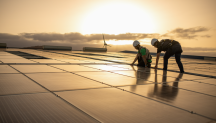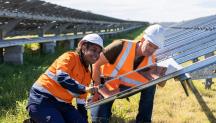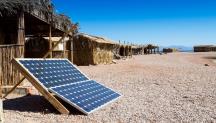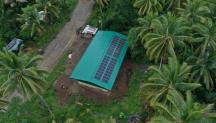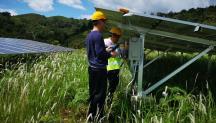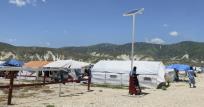

Harnessing the Power of Renewables in Refugee Camps
Newsletter
More than 69 million people have been forced, due to external life-threatening conditions, to leave their homes and seek safety in different countries around the world. According to the Food and Agriculture Organization, refugees often face limited access to fuel and energy, resulting in a wide range of environmental, health, gender, livelihood, disasters and natural resources conflict.
At the 15th Council of IRENA, Simon D’Ujanga, Uganda’s Minister of State for Energy, highlighted the central role renewable energy can play in solving the refugee energy crisis, “SDG7, sustainable energy for all, means energy for the poorest. Uganda has only 21% rural electrification & renewables are helping raise this while being key to reaching more than 1.5 million refugees in Uganda”.
IRENA is providing technical support to UNHCR on the issue of improving electricity access in refugee settings. For this purpose, IRENA will assess and provide renewable energy solutions for the needs of refugee and community households, communal resources (clinics, schools, water pumps, street lights, among others) UNHCR and other related administrative buildings in Iraq and Ethiopia. IRENA will also recommend possible private-sector-linked delivery models that the agency can use to improve electricity provision in refugee settings. The assessment, analyses and recommendations will feed into UNHCR’s global strategy for energy provision in humanitarian response.
Renewable energy offers the prospect of safe, affordable power to the 1.1 billion people currently living without electricity. The number of people served by off-grid renewables globally has expanded six-fold since 2011, reaching nearly 133 million people in 2016. However, efforts are needed to scale-up efforts. Unless we scale-up efforts, 1 billion people will still be without electricity in 2030, and 2.4 billion people will be without clean cooking facilities. IRENA will be exploring ways to increase renewable energy deployment in the developing context at the 2018 International Off Grid Renewable Energy Conference.
Renewable energy is not new to refugee camps. Jordan’s Azraq refugee camp, the world’s first refugee camp powered by renewable energy, houses a 2-megawatt solar photovoltaic plant, allowing the UN Refugee Agency (UNHCR) to provide sustainable energy to more than 20,000 Syrian refugees. Families can now connect fridges, TVs, a fan, have light inside the shelter and charge their phones. This project, funded by IKEA, will contribute to Jordan’s national strategy to achieve a green economy by 2020. It also showcases how corporations and the private sector can contribute to a global transition to cleaner, more sustainable energy.
Another impressive solar project, funded by Germany, is located in Jordan’s Za’atari refugee camp and currently provides energy for more than 80,000 Syrian refugees at a fraction of the energy cost, saving the UNHCR 5.5 million dollars a year to reinvest in other forms of humanitarian assistance. The 12.9 megawatt peak solar photovoltaic plant, cost 17.5 million dollars and is the largest solar plant ever built in a refugee camp.
Building this plant has also brought benefit to the local community by creating employment and building the technical skills of local people. Local Jordanian workers, along with 75 refugees living in the camp were hired to install the 40,000 photovoltaic panels. In addition to that, being connected to Jordan’s national grid, any excess energy produced by the plant can be used by the surrounding Jordanian communities.
The refugee energy crisis is especially unforgiving to refugee women. According to UNHCR, women walk up to ten kilometers a day to collect firewood, leaving them at risk of sexual and gender-based violence. Furthermore, their children are often left behind at the camp increasing the risk of them being abused. The Fund for Refugee Women, established by Sheikha Fatima bint Mubarak in collaboration with the Emirates Red Crescent and UNHCR, aims to improve the lives of refugee women in refugee communities by providing them with access to alternative energy sources.
Without clean energy and sustainable energy solutions many refugees living in impoverished regions depend on firewood to meet their basic energy needs. Cutting down trees for firewood causes deforestation, increased carbon emissions, and can exacerbate tension with the local community, who also rely on those resources. UNHCR believes that the introduction of sustainable forms of energy to those refugee communities would not only diminish the conflict that arises from competition over natural resources, but would also energize the renewable energy market in those impoverished regions, bringing benefit to the host community as well.
IRENA spoke to Toby Harward, head of the UNHCR office in Abu Dhabi, to find out how renewable energy is being utilized by the agency to improve refugee living conditions.
IRENA: Today, refugees are faced with a growing challenges accessing energy. How is renewable energy improving the lives of refugees?
Toby Harward: With the UN General Assembly calling for a more comprehensive and sustainable response to the current unprecedented refugee emergency, access to energy is a fundamental component of UNHCR’s response. Human dignity and self-reliance cannot be achieved without light, heat, power and mobility.
Renewables can provide affordable, safe and sustainable energy solutions, spur sustainable economic growth, and create jobs within both refugee and host communities. Modern energy services help reduce poverty and can play a critical role in improving educational opportunities for children, empowering women and promoting gender equality. UNHCR has become increasingly interested in using renewable energy to power our installations, as well as big camps and smaller settlement settings.
In 2017, Jordan switched on solar photovoltaic plants at UNHCR’s two largest refugee camps, Zaatari and Azraq, transforming the lives of over 100,000 Syrian refugees. Families now power their shelters, run essential electrical appliances, recharge their phones, study and work after dark, and walk safely at night. The 12.9MW solar plant in Zaatari and 5MW plant in Azraq saves UNHCR $12.5 million per year in electricity costs, and reduces carbon emissions by over 20,000 tons a year. In Azraq, so far more than fifty refugees have benefitted from training and employment by Jordanian solar company, Mustakbal. And with both plants connected to the Jordanian national electricity grids, unused electricity generated can be fed back into the network at no cost, helping support the energy needs of host communities.
IRENA: In order to meet their energy needs, refugees often resort to firewood and charcoal collection. What are the environmental and health implications of this?
Toby Harward: Firewood and charcoal collection have significant implications on environment and health. In Bangladesh, some 700,000 Rohinyga refugees have few options other than firewood for their household energy needs. It is estimated that over 820 tonnes of trees or over 4 hectares per day are being cut down to provide cooking fuel. Wildlife habitats have been severely impacted. In addition, firewood collection raises tensions with the host community who seek to protect their natural resources and livelihoods, and increases risks of assault.
With regard to health, the smoke created by 191,000 families in such a densely populated area is negatively impacting the health of the whole population, especially those directly involved in tending fires and cooking.
IRENA: What technologies are being considered/prioritized by UNHCR?
Toby Harward: UNHCR is starting to examine the use of small, versatile and hybrid technologies, flyaway power and life-support systems, which can be optimized and deployed for humanitarian operations globally, significantly reducing current inefficient and costly diesel solutions. Increasingly we are seeking financing for mini-grid systems, solar-powered lanterns, street lights, boreholes and water pumps to power refugee settlements and provide clean drinking water, sanitation and hygiene projects to small communities in austere and off-grid locales.
Fuel-efficient cook stoves and sustainable biomass products are starting to address the harmful impact of cooking fuels and inefficient open fires on the health and well-being of refugees, as well as on the environment. In Rwanda, a social enterprise, Inyenyeri, has developed locally-made fuel pellets which have dramatically reduced the amount of biomass required for cooking and exposure to toxic emissions. In Niger, Tanzania and Bangladesh, UNHCR, its partners and local natural gas suppliers are supporting the distribution of Liquefied Petroleum Gas as a clean energy substitute to firewood and charcoal. LPG distribution has already had a dramatic impact in curbing environmental degradation, carbon emissions, and intercommunal tensions in areas where it is in operation.
IRENA: A more decentralized approach to the introduction of renewable energy allows for energy solutions that fit the local context through a bottom-up approach. How are local communities being involved in the development of renewable energy projects?
Toby Harward: UNHCR places great importance in its participatory approach, involving refugees in all activities related to their lives and well-being. When the Canadian Government announced its willingness to fund a project to introduce clean cooking techniques in Uganda’s Nakivale refugee settlement, UNHCR organized a pilot for women to trial the making of environment-friendly biomass briquettes and energy-saving mud stoves. More than 200 households took part in the pilot. Those who took part learned how to make the stove as well as the briquettes – a biofuel substitute for wood and charcoal made of mud, organic waste and agricultural residue.
Local communities play a big role in sustainable energy projects. In Rwanda, local companies crowd-source out to local farmers the making of their biomass briquettes. In Niger and Tanzania, local civil society programmes have helped educate refugees and local communities in sustainable agriculture techniques, including agro-forestry. And in the solar fields of Zaatari and Azraq camps in Jordan, local refugees are now employed in the maintenance of the panels providing new opportunities for livelihoods.
IRENA: What can governments do to support the development and deployment of renewable energy solutions for refugees?
Toby Harward: At the UN General Assembly in September 2016, all 193 Member States recognized that more must be done to deal with the current refugee crisis, and laid out a vision for a more comprehensive and a more sustainable response. The General Assembly envisioned a world where refugees have access to countries in which they are safe, where they are better included within local societies, and where they can become self-reliant and no longer solely dependent on humanitarian aid. In short, refugees need more mobility, more opportunity and more sustainability.
In order to be self-reliant, refugees must have access to education, access to livelihoods and access to energy. The UAE understands this well, and is now supporting important UNHCR activities in Uganda designed to provide South Sudanese refugees and Ugandan host communities with an education, with livelihood opportunities, and with sustainable water systems.
As the price of solar energy has tumbled, and power distribution systems have become more mobile and versatile, renewable energy has the potential to transform the lives of refugees. With the UAE at the forefront of the renewable energy revolution, UNHCR hopes the country will play a big role providing hope, dignity and opportunity to the most vulnerable persons on the planet.
